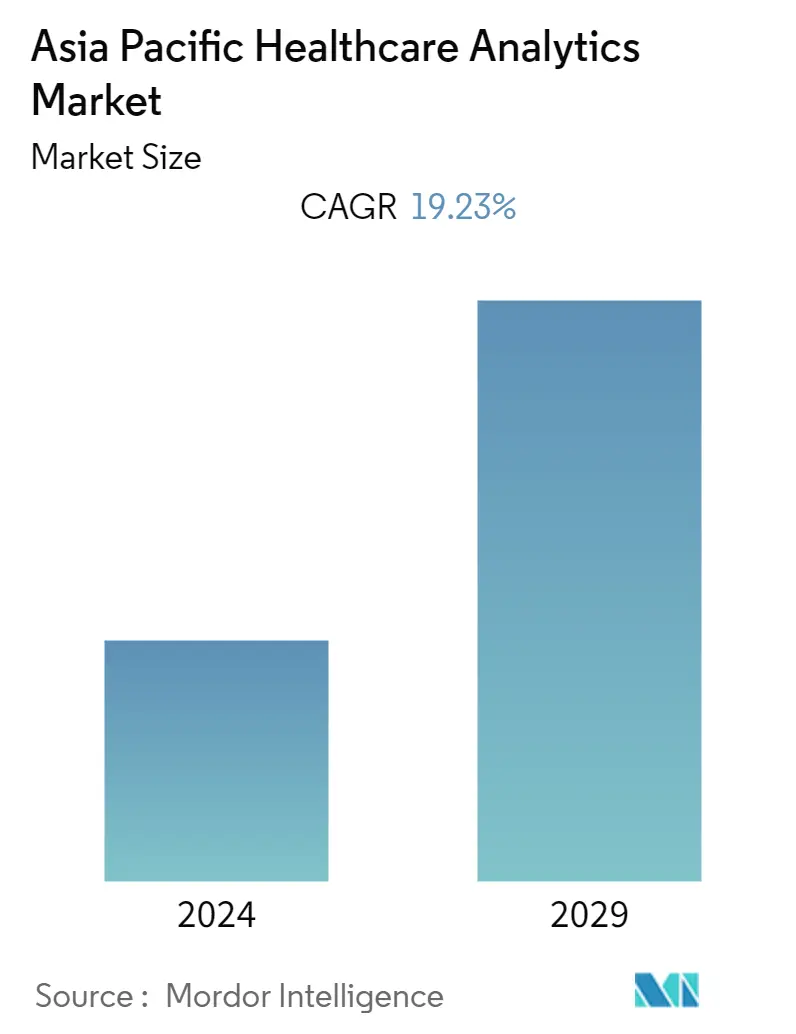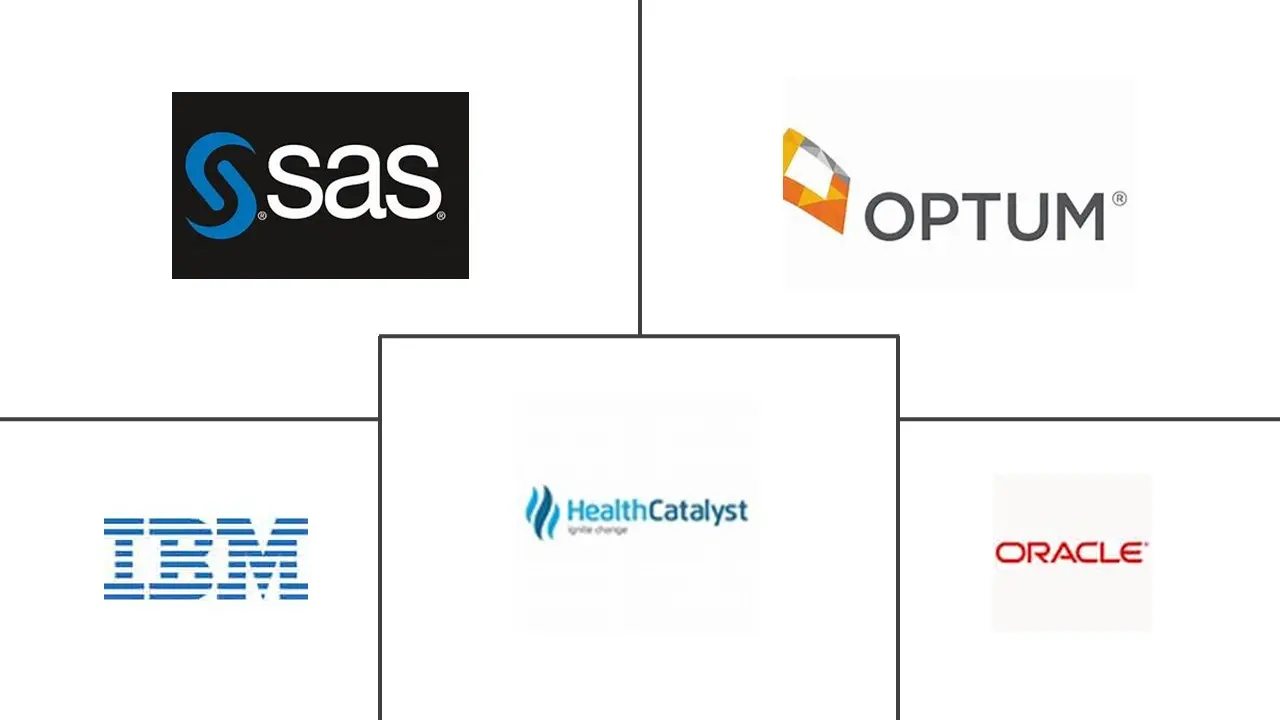Market Size of Asia Pacific Healthcare Analytics Industry

| Study Period | 2019 - 2029 |
| Base Year For Estimation | 2023 |
| Forecast Data Period | 2024 - 2029 |
| Historical Data Period | 2019 - 2022 |
| CAGR | 19.23 % |
| Market Concentration | Medium |
Major Players
*Disclaimer: Major Players sorted in no particular order |
Asia Pacific Healthcare Analytics Market Analysis
During the forecast period, the Asia Pacific Healthcare Analytics Market is expected to register a CAGR of 19.23%.
- There has been exponential growth in the healthcare analytics market due to the rise of the IT healthcare sector. Healthcare analytics can predict future trends, measure performance, and evaluate decisions using chronological data. This will help improve patient care by advancing accuracy, efficiency, and service delivery.
- The healthcare sector, in general, has been faced with challenges such as the need for improved patient care, rising treatment costs, and decreased patient retention. Consequently, healthcare analytics are getting integrated into every sector to provide better treatment to patients and improve industry operations. These are significant factors driving the expansion of the healthcare analytics industry.
- They are adopting big data analytics in healthcare, resulting in cost-effective medication, insurance planning concerning population health, and better diagnostic approaches. Because of this, there is an increase in the number of customers, leading to better investments in the sector.
- Security issues, technological and cultural barriers, and fragmented international political relations hinder the market's growth. The growth of the market is also slowed by the fact that most of the information sent in this sector is private.
- The COVID-19 outbreak increased the use of big data analytics for public healthcare surveillance and disease tracking. As a result, the sector in this region witnessed a significant boom owing to a rise in the necessity for digital solutions and improved analytics tools to handle the patient burden on the healthcare industry. The volume of clinical data collected during the pandemic required adequate management, and researchers and experts could extract better outcomes, forecast trends, and analyze disease transmission dynamics much better by using analytics tools and platforms.
Asia Pacific Healthcare Analytics Industry Segmentation
Healthcare analytics, also known as clinical data analytics, is the branch of analysis that provides insights into patient records, hospital management, and diagnosis. Healthcare analytics permits the examination of patterns across multiple healthcare datasets to determine the improvement of medical care while limiting expenditure. The report examines the Asia-Pacific healthcare analytics market by application, including clinical, financial, predictive modeling, operational and administrative, and research; delivery mode, including premise, web-hosted, and cloud-based; components; and end users, including healthcare, payers, and providers.
The market sizes and forecasts are provided in terms of value (USD million) for all the above segments.
| By Deployment | |
| On-Premise | |
| Cloud |
| By Application | |
| Clinical Data Analytics | |
| Financial Data Analytics | |
| Operational/Administrative Data Analytics |
| By End-User | |
| Healthcare Provider | |
| Pharmaceutical Industry | |
| Biotechnology Industry | |
| Academic Organization |
| By Country | |
| China | |
| Japan | |
| India | |
| South Korea | |
| Australia | |
| Indonesia | |
| Rest of Asia Pacific |
Asia Pacific Healthcare Analytics Market Size Summary
The Asia Pacific healthcare analytics market is experiencing significant growth, driven by the increasing integration of IT solutions within the healthcare sector. This expansion is largely attributed to the need for improved patient care, cost-effective treatment options, and enhanced operational efficiency. Healthcare analytics plays a crucial role in predicting trends, measuring performance, and evaluating decisions, which in turn helps to advance patient care through improved accuracy and service delivery. The adoption of big data analytics is particularly notable, as it facilitates better diagnostic approaches and supports insurance planning related to population health. Despite these advancements, the market faces challenges such as security concerns, technological barriers, and fragmented political relations, which can impede growth. The COVID-19 pandemic further accelerated the adoption of analytics tools, as they proved essential in managing the surge of clinical data and improving public health surveillance.
The demand for remote patient monitoring solutions is a key factor propelling the market's growth, especially in light of the aging population and the prevalence of chronic diseases. Hospitals are increasingly turning to modern technologies and analytics to enhance patient care while reducing costs. The adoption of cloud analytics is also on the rise, driven by increased health consciousness and the need to manage extensive medical data efficiently. Favorable government policies, such as Japan's universal insurance schemes, have further bolstered the market. In China and India, the adoption of IT solutions and the development of better IT skills are significant contributors to market growth. Notable developments include the creation of a 5G-based telemedicine platform in China and the launch of an AI-powered health data platform in India. Major players like IBM, SAS Institute, and Oracle are introducing new trends and solutions, such as cloud-based data platforms and specialty drug management solutions, which are expected to shape the market's future.
Asia Pacific Healthcare Analytics Market Size - Table of Contents
-
1. MARKET DYNAMICS
-
1.1 Market Overview
-
1.2 Market Drivers
-
1.2.1 Technological Advancements and Favorable Governemnt Initiatives
-
1.2.2 Emergence of Big Data in the Healthcare Industry
-
-
1.3 Market Restraints
-
1.3.1 Cost and Complexity of Software
-
1.3.2 Data Integrity and Privacy Concerns
-
1.3.3 Lack of Proper Skilled Labors
-
-
1.4 Value Chain / Supply Chain Analysis
-
1.5 Porter's Five Forces Analysis
-
1.5.1 Threat of New Entrants
-
1.5.2 Bargaining Power of Buyers
-
1.5.3 Bargaining Power of Suppliers
-
1.5.4 Threat of Substitute Products
-
1.5.5 Intensity of Competitive Rivalry
-
-
-
2. MARKET SEGMENTATION
-
2.1 By Deployment
-
2.1.1 On-Premise
-
2.1.2 Cloud
-
-
2.2 By Application
-
2.2.1 Clinical Data Analytics
-
2.2.2 Financial Data Analytics
-
2.2.3 Operational/Administrative Data Analytics
-
-
2.3 By End-User
-
2.3.1 Healthcare Provider
-
2.3.2 Pharmaceutical Industry
-
2.3.3 Biotechnology Industry
-
2.3.4 Academic Organization
-
-
2.4 By Country
-
2.4.1 China
-
2.4.2 Japan
-
2.4.3 India
-
2.4.4 South Korea
-
2.4.5 Australia
-
2.4.6 Indonesia
-
2.4.7 Rest of Asia Pacific
-
-
Asia Pacific Healthcare Analytics Market Size FAQs
What is the current Asia Pacific Healthcare Analytics Market size?
The Asia Pacific Healthcare Analytics Market is projected to register a CAGR of 19.23% during the forecast period (2024-2029)
Who are the key players in Asia Pacific Healthcare Analytics Market?
Optum Inc, SAS Institute Inc, IBM Corporation, Oracle Corporation and Health Catalyst are the major companies operating in the Asia Pacific Healthcare Analytics Market.

